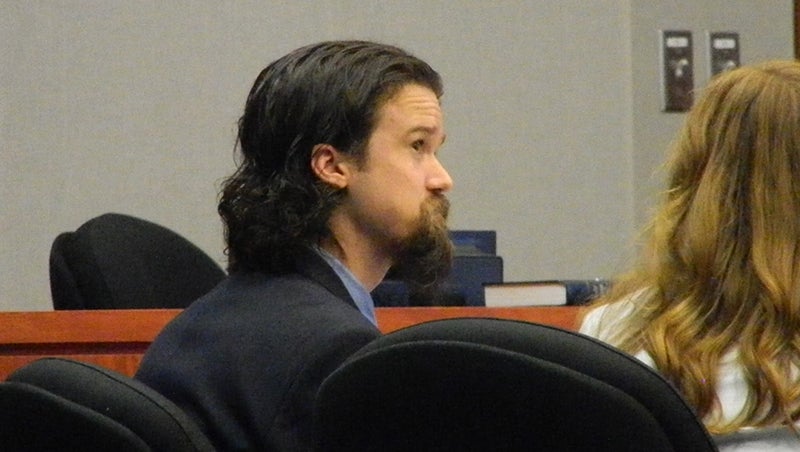Tolson trial day three: Testimonies from family member, medical experts and former employer
Published 8:55 am Thursday, August 31, 2023

- John Curtis "Jay" Tolson at the Dare County Superior Court defendant's table. Philip S. Ruckle Jr. photo
|
Getting your Trinity Audio player ready...
|
Just before 10 a.m. Wednesday, day three of John Curtis “Jay” Tolson’s trial reconvened at the Dare County Courthouse in Manteo to hear four witness testimonies.
Tolson is charged with the second-degree murder in the July 2020 death of Amanda LeeAnn Fletcher Hartleben, a 38-year-old Kitty Hawk resident and mother of two. Tolson has pleaded not guilty; therefore state prosecutors bear the burden to prove his responsibility for Hartleben’s death. Twelve jurors will determine Tolson’s fate at the conclusion of the trial.
After the jury took their seats, Pitt County Superior Court Judge Jeffery B. Foster reminded them to focus on the case and not on the weather.
The prosecution team, led by Assistant District Attorney Jennifer Bland, called their first witness to the stand, Trisha Cahoon. Though they were cousins, Cahoon said she thought of Hartleben like a sister. When Cahoon began to cry on the witness stand, Judge Foster dismissed the jury and scolded Cahoon.
“I know you’re upset. I know you’ve mourned. But it’s been three years. I need you to pull it together. I won’t have your tears influence [the jury]. You’ve known this is coming and you’ve prepared for it,” Judge Foster said.
The jury returned to the courtroom and Cahoon continued her testimony.
Cahoon described her cousin as someone who liked to bake cakes and liked to cook. She enjoyed gardening, decorating her home and fishing. She was involved in the schools of her two children, aged 5 and 14 at the time of her death, according to Cahoon.
Exhibits 2 and 3 were introduced to the court. The exhibits were photos of Hartleben as Cahoon said she looked in July 2020 and were distributed to the jury. The defense later said that the photos were from 2016.
Cahoon explained the chain of events leading up to her discovery of Hartleben’s injuries and subsequent death. She was notified by Hartleben’s mother on July 23 that her cousin was at Sentara Norfolk General Hospital. When Cahoon arrived at the hospital on July 24, she said Hartleben was unresponsive to any kind of stimuli. She was connected to a ventilator and cardiac monitor, and a portion of her head had been shaved from the craniectomy, a neurosurgical procedure that removes part of the skull to relieve pressure from the brain.
Bruises were observed on Hartleben’s body by Cahoon. She noted bruises on her wrists, hands, feet, chest, ankles, shoulders, legs, and in between her fingers. Cahoon’s photographs of the bruises were turned over to the jury as Exhibits 4, 5 and 6.
Tolson, who remained silent throughout the witness proceedings, leaned over slightly to look at a copy of the photos in front of his lawyer. His dark hair was combed back and reached the shoulders of his olive-colored suit. He showed little emotion throughout the day, his thick goatee covering part of his face.
Cahoon said “when things weren’t adding up” she and the family contacted the Kitty Hawk Police Department on July 24, 2020, and members of the police department came out the next day. The family later hired a private investigator.
The prosecution asked Cahoon about her communication with Tolson. She said she reached out after the incident to find out what happened but he never responded. Tolson did not attend Hartleben’s funeral.
The defense, led by Assistant Public Defense Attorney Christan Routten, began to cross examine the witness, asking about her communication with Tolson. Though Cahoon said she has never spoken to him, the defense read Cahoon’s own Facebook messages to Tolson, including: “Mother f**er you’d better run as fast as you can. It’s your night.” Another read “Do not pick up this guy hitchhiking. He will murder you.”
“Yes, I’m not going to deny that at all,” Cahoon admitted, later saying that she was “in a really bad state.”
“Something bad had happened to my cousin and I was trying to get to the bottom of it,” she added.
The defense asked then if Cahoon was surprised that Tolson did not attend the funeral, to which she responded, “I’m surprised he didn’t reach out to the family.”
Tolson’s lawyer then moved on to discuss Cahoon’s social media activities, which included a “Justice for LeeAnne” Facebook page and a YouTube channel where she posted a Facebook Live video tour in Hartleben’s Kitty Hawk home discussing her cousin’s death.
When asked if LeeAnne was an alcoholic, Cahoon said she could not answer that because she didn’t live with her. She also declined knowledge of whether Hartleben drank daily.
“You said you guys were like sisters but you don’t know if she was an alcoholic or not?” the defense asked Cahoon.
“Yes, we were like sisters,” was Cahoon’s response.
After about 45 minutes on the witness stand, Cahoon was released. She remained in the courtroom for the rest of day, with the exception of when graphic medical photos were shown.
The state then called to the witness stand Dr. Jessica Burgess, trauma surgeon at Sentara Norfolk General Hospital, where Hartleben was medi-flighted on July 22.
Upon arriving at the hospital, Burgess examined Hartleben, who was placed on alpha alert, or the highest level of alert. The doctor said there was a significant amount of blood coming from Hartleben’s nose and mouth. Labs were performed that revealed no alcohol in her system. Labs also revealed that Hartleben had liver failure.
Also noted by the doctor were various bruises and what appeared to be a burn on her buttocks. Burgess said, based on the EMS report the fact that Hartleben wasn’t waking up, that her team assumed Hartleben had sustained some kind of head injury.
Hartleben was referred for a CT scan, which is standard practice for trauma patients, to look for any type of injury, signs of bleeding, or broken bones. Her scan revealed a very large amount of blood in her skull, putting pressure on her brain, and she was immediately taken into the operating room for a craniectomy.
Burgess said the injury was life threatening and can result in brain death without treatment.
The prosecution asked Burgess if it were possible to tell on the CT scan when the injury occurred. The defense objected, but Judge Foster overruled the request and the witness was allowed to continue.
Burgess said it is possible to “vaguely tell old blood from new blood” and named the injury as “acute within 6-12 hours.”
The doctor added that the injury came from “some sort of force” that caused the brain to tear away from the skull, causing the blood vessels to tear away and bleed.
Though the craniectomy was successful in removing the blood and pressure from Hartleben’s brain, she was not able to breathe on her own, her blood pressure was low, her heart rate was high, and there was lactic acidosis in her blood, evidence of severe liver failure.
While Burgess’s primary diagnosis was severe traumatic brain injury, she admitted it was possible that a head injury could exacerbate any other preexisting illnesses a patient may have.
During cross examination, the defense read Burgess’s chart notes from July 23 and 24: “With the combination of cirrhosis and brain injury, I do not think this is survivable.”
Hepatic cirrhosis is disease that causes scarring and liver failure.
“Patients die from acute liver failure, and it looks like that’s what happened,” Burgess told the court. “While the head injury was not necessarily fatal, the failing liver was.”
Hartleben succumbed to her injuries on July 25 after three days in the hospital.
After a short break, the court reconvened at about 11:45 a.m. Burgess confirmed that Hartleben’s liver condition was worsening while she was at the hospital. She was dismissed from the witness stand, and the prosecution called Assistant Chief Medical Examiner Dr. Nicole Masian of the Virginia Office of the Chief Medical Examiner.
Masian is a forensic pathologist, which she described as a position “where medicine meets the law.” She performed Hartleben’s autopsy on July 28, 2020 and determined the cause and manner of death.
She explained her initial observations – evidence of blunt force trauma to the head with subsequent surgery, multiple bruises, swelling and jaundiced skin.
Masian talked about the findings that she described as common from medical interventions like bruises on Hartleben’s chest because of CPR, or bruises on her hands from IVs or on her arms when EMS workers moved her from the bathtub to a gurney. Bruises on her lower legs she said were evidence of bumping into things or falling. Bruising is more common in people with liver failure.
Then she discussed bruises that she did not find ordinary.
Masian said the presence of multiple bruises on the backs of Hartleben’s forearms and hands raises the question of “defense or scrimmage-type activities.” She described scrimmage activities as “striking a blow as opposed to defending a blow” and raised her fists to the jury in a punching motion to demonstrate.
The medical examiner added that bruises on the inner thighs, where she noted at least half a dozen, would be unusual from a fall or a medical intervention.
She mentioned that Hartleben had a laceration inside her upper lip that she could not date specifically but it was in the healing stage and could have been caused by blunt force injury.
The burn that trauma doctor Burgess had noted Masian said was actually a bedsore. Hartleben also had pneumonia, which Masian said was not uncommon to contract during hospitalization.
The autopsy revealed significant liver disease and blunt force trauma to the head.
“Something blunt caused bleeding inside her head,” Masian said. The bleeding, called a subdural hematoma, result from tears in bridging veins in the brain. The subdural hematoma, Masian said, was about the size of the palm of her hand. “It takes a significant amount of force … to cause that tear,” she said, adding later that “the brain would have to rattle considerably to cause that tearing.”
Liver damage means she would have been prone to bleed excessively, Masian said. One of the functions of the liver is to aid in clotting the blood in case of an injury. When the liver isn’t functioning, blood fails to clot properly. “When she started bleeding she would have bled and bled and bled.”
The medical examiner said Hartleben had had underlying liver disease for months or years. Her liver cirrhosis was “not immediately fatal” and she could have lived for months or years with it, Masian said. And while the cirrhosis did not cause the bleeding, when she started to bleed, the cirrhosis caused her to keep bleeding.
She also noted that lab tests that she ordered did not reveal drugs or ethanol (alcoholic beverages) in the blood. During cross examination, Tolson’s defense lawyers had Masian confirm that in the tests performed, Hartleben did not have any other broken bones or fractures anywhere else.
In her final autopsy report, Masian declared the cause of death as “complications of blunt force trauma to the head with hepatic cirrhosis with clinical hepatic failure contributing,” and ruled that the manner of death was “undetermined.”
The defense clarified that blunt force trauma does not mean it’s intentional. Masian confirmed that she means blunt as opposed to sharp; trauma as opposed to natural. Blunt force trauma can be from a fall, from striking an object, or a shove that can result in a head striking the wall.
“It’s not clear what it was, but the injury was clearly due to blunt force trauma,” Masian reiterated.
Masian had five options for the manner of death: natural, suicide, homicide, accident, or undetermined. “It was clearly not a natural death. There was no evidence to determine suicide, and insufficient evidence for me to classify it as a homicide or an accident,” she told the court.
When asked about the timing of the injury, Masian only said that it had to be days old from when she examined her. This was unhelpful information for the prosecution, which has speculated that Tolson did not immediately report Hartleben’s injuries.
After another 15 minute recess, the final witness, Nicholas Bateman, was called to the stand. Bateman owns a home remodeling company and employed Tolson off and on for several years. Tolson is also related to Bateman’s ex-wife.
Bateman said that after learning of the situation on Facebook, he offered Tolson a ride to the Kitty Hawk Police Department on the night of July 24. He picked him up at the Red Drum convenience store in Buxton, and the two spoke a little on the ride.
“We talked a little bit. He didn’t have a whole lot to say,” Bateman recalled. He described Tolson’s demeanor as scared and shocked, and said he didn’t eat much of the food that Bateman brought him.
“He said they were drinking, Mr. Tolson and LeeAnn I guess is her name. Maybe there were some pills involved. He said she stumbled back and hit her head on the couch,” Bateman recalled from his July 24, 2020 conversation.
According to Bateman, Tolson said Hartleben was taking a kind of muscle relaxer called Flexeril. Tolson told Bateman that he and LeeAnn were arguing, and he found her in the tub the next morning.
Bateman waited in the truck while Tolson spoke with the Kitty Hawk Police Department, and then gave him a ride back to Buxton.
On the way back, Bateman said Tolson was obviously scared, and he was upset and crying.
“He said he didn’t know what was going to happen. He didn’t go into detail,” Bateman recalled. Bateman confirmed that Tolson had a cell phone with him in the car.
Just after 4 p.m., Bateman was dismissed from the witness stand, and the judge began his final instructions for the day.
Judge Foster reminded the jury not to discuss the case with anyone else, nor to make any determinations until all the evidence has been presented. Jurors were instructed not to read news or social media pertaining to the case, nor to research anything related to the case on the internet.
After it was announced in court that there would not be a session Thursday due to weather, notification was sent early Thursday morning that proceedings would convene after all.
UPDATE:
RELATED:
SUBSCRIBE TO THE COASTLAND TIMES TODAY!






